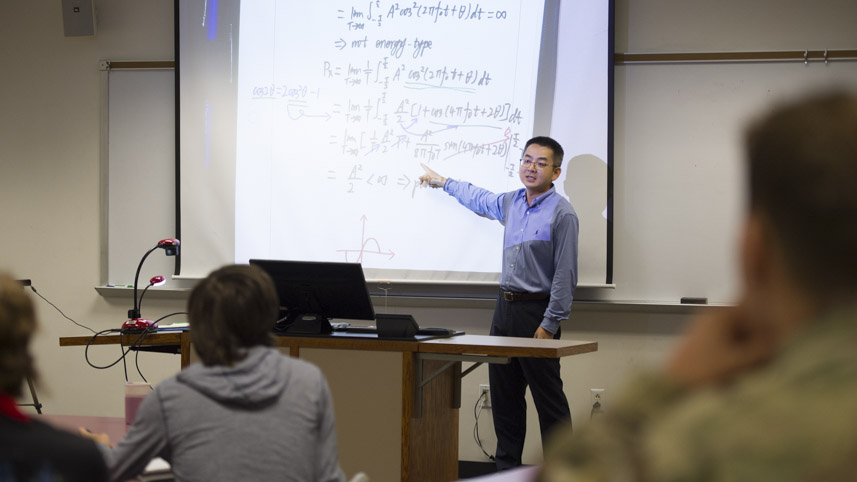by Julia Swain, Student Public Relations Writer
In 2022, according to research studies by the University of Pittsburgh and the University of Texas, approximately 5 in 10 concussions were undiagnosed, due largely in part to the subjectivity of typical concussion tests.
Seeing this negative trend, Dr. Edward Meng, now an assistant professor of computer engineering at Cedarville University, sought to find a solution to this problem with help from faculty members at Auburn University, where he completed his doctoral studies. At the time, he was an electrical engineering faculty member at Mount Vernon Nazarene University in Ohio. 
“According to Centers for Disease Control and Prevention (CDC), almost 80% of concussions are undiagnosed, which is problematic for athletes,” said Meng. “It is important to try to find a solution for the health of athletes.”
As a result of the research findings, he began to partner with his doctoral faculty at Auburn and the University of Alabama at Birmingham.
In the early research phase, Meng is currently developing a technology that will help detect concussions in athletes in real time. This technology resembles a contact lens-type device that will instantaneously detect concussion symptoms.
Once implemented, the device could be revolutionary in all aspects of professional, intercollegiate, and interscholastic athletics.
“The technology we are developing will help to detect real-time, on-field diagnosis of concussions,” added Meng.
A study that was performed on 243 collegiate athletes by Daniel M. Torres, a neurology specialist with the New York-based Northwell Health showed that 43% of athletes who suffered from mild traumatic brain injuries (TBIs) knowingly hid their symptoms to stay in the game they were playing. Both the inability to detect concussions instantaneously and the ability of athletes to hide their symptoms upon impact contribute to the difficulty of accurately diagnosing concussions and distinguishing their severity.
“The reason concussions are difficult to diagnose is because the technique used [for concussion detection] is MRI or CT scanning,” Meng said. “Athletes may tend to hide their symptoms to stay in the game, so now all of this working together makes it difficult to detect concussions.”
Meng’s technology will help athletic trainers and other medical personnel detect an athlete’s eye movement following head trauma.
“The eyes are the window to the brain, so we’re trying to use the eyeballs within the first 20 seconds of impact to reflect what happened to the brain or use it as a surrogate for the brain,” Meng said.
Because the first 20 seconds of impact following head trauma is the most important, Meng is passionate about developing a technology that can instantaneously help with the detection process.
“So, we want to use some device that can detect the concussion in real-time when it happens and also keep a record of it, have a quick estimation where they are [health-wise] immediately after they got the body impact,” Meng said.
One of the major issues with this, however, is seen in the fact that it is impossible to detect the motion of the brain and, consequently, the damage that is taking place from the outside.
“When the body impact or head impact takes place, the head [movement] might stop but the brain may keep bouncing back and forth, causing sequential injuries inside, which is not visible from the outside,” said Meng. “Currently there’s no way to just reach into the brain to record what happens to the brain in real-time.”
Currently, Meng’s solution is to make the sensors contactless, so that they can even be worn during intense athletic activity.
Before this technology can be fully developed, there are a few more steps that Meng and his team must take.
“The next step is to make the final connection between the eyeball and the human brain and also make the instrumentation of making the wireless communication between the contactless sensor and also the reader outside because you cannot just put the wires onto the sensor,” Meng said. “It has to be totally wireless to be wearable.”
Meng also plans to involve Cedarville students in the research process and looks to present this research to multiple degree programs within the engineering, science and math departments.
“The project outcome will benefit Cedarville University and the students here. Undergraduate students at the school of engineering and computer science will be involved in the research project,” Meng said. “The research outcomes will be published and presented in physics, biology, engineering, statistics, machine learning, and data mining-related journals; conferences; and workshops,”
If this technology were to be in working order, it could change the lives of athletes and revolutionize the athletic training industry for years to come.
Located in southwest Ohio, Cedarville University is an accredited, Christ-centered, Baptist institution with an enrollment of 5,456 undergraduate, graduate, and dual enrolled high school students in more than 175 areas of study. Founded in 1887, Cedarville is one of the largest private universities in Ohio, recognized nationally for its authentic Christian community, rigorous academic programs, high graduation and retention rates, accredited professional and health science offerings, and the #4 national ranking by the Wall Street Journal for student engagement. For more information about the University, visit cedarville.edu.


















